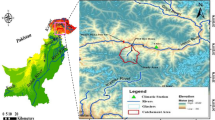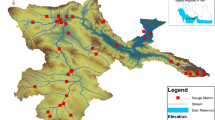Abstract
In the field of water quality management, it is vital to determine the main precursory anomalies from the precursor of intricate water bloom in the context of a given area. In this paper, a water bloom precursor analysis method, based on two direction singular rough set, was proposed. This approach was produced on the basis of the different sections and pre-water bloom of water bloom precursor anomalies and characteristic of elements transferred in singular rough set. For testing the validity of two direction singular rough set application in water bloom precursor analysis, Xiangxi River, which is one of the typical tributaries of Three Gorges Reservoir in China, was selected as study area. The result showed that compared with other indexes, pH and dissolved oxygen (DO) are the most valuable indicators of water bloom in the precursory anomalies. Furthermore, regarding with water bloom precursory anomalies in Xiangxi River, most of the nutrient loading and biological community are the key indicators. Hence, this method can determine the main precursory anomaly for water bloom in the study area, which provides powerful knowledge support to water quality specialists for them to comprehensively analyze precursory anomaly so as to find out its relationship with occurrence law of water bloom.











Similar content being viewed by others
References
Dzialowski AR, Wang SH, Lim NC, Spotts WW, Huggins DG (2005) Nutrient limitation of phytoplankton growth in central plains reservoirs, USA. J Plankton Res 27:587–595. doi:10.1093/plankt/fbi034
Eri K, Kudo I (2016) Significant contribution of lytic mortality to bacterial production and DOC cycles in Funka Bay, Japan. J Oceanogr 72:177–187. doi:10.1007/s10872-015-0316-2
Fu H, Shi K (2009) Function S-rough sets and two law forecast. J Syst Eng Electron 20:332–338
Ghosh M (2010) Modeling biological control of algal bloom in a lake caused by discharge of nutrients. J Biol Syst 18:161–172. doi:10.1142/S021833901000324X
Grattan LM, Holobaugh S, Morris JG (2016) Harmful algal blooms and public health. Harmful Algae 57:2–8. doi:10.1016/j.hal.2016.05.003
Heisler J, Glibert PM, Burkholder JM, Anderson DM, Cochlan W, Dennison WC, Dortch Q, Gobler CJ, Heil CA, Humphries E, Lewitus A, Magnien R, Marshal HG, Sellner K, Stockwell DA, Stoecker DK, Suddleson M (2008) Eutrophication and harmful algal blooms: a scientific consensus. Harmful Algae 8:3–13. doi:10.1016/j.hal.2008.08.006
Hu H, Yan W, Shi K (2007) S-rough communication and its characteristics. J Syst Eng Electron 18:148–154
Huang Y, Zhang W, Xie W, Tang D, Zhang H, Du C (2013) Influence of ions on dynamic response of surface plasmon resonance fiber optic sensor. Sensors Actuators B Chem 186:199–204. doi:10.1016/j.snb.2013.06.008
Kim Y, Shin HS, Plummer JD (2014) A wavelet-based autoregressive fuzzy model for forecasting algal blooms. Environ Model Softw 62:1–10. doi:10.1016/j.envsoft.2014.08.014
Kong XM, Huang GH, Fan YR, Li YP (2015) Maximum entropy-Gumbel-Hougaard copula method for simulation of monthly streamflow in Xiangxi river, China. Stoch Env Res Risk A 29:833–846. doi:10.1007/s00477-014-0978-0
Liu Y, Wang Z, Guo H, Yu S, Sheng H (2013) Modelling the effect of weather conditions on cyanobacterial bloom outbreaks in Lake Dianchi: a rough decision-adjusted logistic regression model. Environ Model Assess 18:199–207. doi:10.1007/s10666-012-9333-3
Lv X, Zhang W, Wu S (2012) Variety of chlorophyII-a and its correlations with environmental factors before and after algal bloom. Yellow River 34:73–75. doi:10.3969/j.issn.1000-1379.2012.02.026
Mallin MA, Parsons DC, Johnson VL, McIver MR, CoVan HA (2004) Nutrient limitation and algal blooms in urbanizing tidal creeks. J Exp Mar Biol Ecol 298:211–231. doi:10.1016/S0022-0981(03)00360-5
Mao JQ, Lee JHW, Choi KW (2009) The extended Kalman filter for forecast of algal bloom dynamics. Water Res 43:4214–4224. doi:10.1016/j.watres.2009.06.012
Matula J, Sychová M, Drmotová A (2000) The effect of nitrogen fertilizers on pool of labile forms of sulphur and nitrogen in soil. Rostlinná Výroba 46:29–35
Paerl HW, Xu H, Hall NS, Rossignol KL, Joyner AR, Zhu G, Qin B (2015) Nutrient limitation dynamics examined on a multi-annual scale in Lake Taihu, China: implications for controlling eutrophication and harmful algal blooms. J Freshw Ecol 30:5–24. doi:10.1080/02705060.2014.994047
Pai PF, Lee FC (2010) A rough set based model in water quality analysis. Water Resour Manag 24:2405–2418. doi:10.1007/s11269-009-9558-3
Parinet B, Lhote A, Legube B (2004) Principal component analysis: an appropriate tool for water quality evaluation and management—application to a tropical lake system. Ecol Model 178:295–311. doi:10.1016/j.ecolmodel.2004.03.007
Park K, Jung HS, Kim HS, Ahn SM (2005) Three-dimensional hydrodynamic-eutrophication model (HEM-3D): application to Kwang-Yang Bay, Korea. Mar Environ Res 60:171–193. doi:10.1016/j.marenvres.2004.10.003
Pawlak Z (1982) Rough sets. Int J Comput Inform Sci 11:341–356. doi:10.1007/BF01001956
Pawlak Z, Skowron A (2007) Rudiments of rough sets. Inf Sci 177:3–27. doi:10.1016/j.ins.2006.06.003
Ptacnik R, Andersen T, Tamminen T (2010) Performance of the Redfield ratio and a family of nutrient limitation indicators as thresholds for phytoplankton N vs. P limitation. Ecosystems 13:1201–1214. doi:10.1007/s10021-010-9380-z
Rastogi RP, Madamwar D, Incharoensakdi A (2015) Bloom dynamics of cyanobacteria and their toxins: environmental health impacts and mitigation strategies. Front Microbiol 6:S53–S55. doi:10.3389/fmicb.2015.01254
Sha J, Jo YH, Oliver MJ, Kohut JT, Shatley M, Liu WT, Yan XH (2015) A case study of large phytoplankton blooms off the New Jersey coast with multi-sensor observations. Cont Shelf Res 107:79–91. doi:10.1016/j.csr.2015.07.006
Shukla JB, Misra AK, Chandra P (2008) Modeling and analysis of the algal bloom in a lake caused by discharge of nutrients. Appl Math Comput 196:782–790. doi:10.1016/j.amc.2007.07.010
Srivastava A, Singh S, Ahn CY, Oh HM, Asthana RK (2013) Monitoring approaches for a toxic cyanobacterial bloom. Environ Sci Technol 47:8999–9013. doi:10.1021/es401245k
Thomas D, Schallenberg M (2008) Benthic shear stress gradient defines three mutually exclusive modes of non-biological internal nutrient loading in shallow lakes. Hydrobiologia 610:1–11. doi:10.1007/s10750-008-9417-x
Wehr JD, Descy JP (1998) Use of phytoplankton in large river management. J Phycol 34:741–749. doi:10.1046/j.1529-8817.1998.340741.x
Wu YL, Li L, Zheng LL, Dai GY, Ma HY, Shan K, Wu HD, Zhou QC, Song LR (2016) Patterns of succession between bloom-forming cyanobacteria Aphanizomenon Flos - Aquae and Microcystis and related environmental factors in large, shallow Dianchi Lake, China. Hydrobiologia 765:1–13. doi:10.1007/s10750-015-2392-0
Yan HY, Huang Y, Wang GY, Zhang XR, Shang MS, Feng L, Dong JH, Shan K, Wu D, Zhou BT, Yuan Y (2016a) Water eutrophication evaluation based on rough set and petri nets: a case study in Xiangxi-River, three gorges reservoir. Ecol Indic 69:463–472. doi:10.1016/j.ecolind.2016.05.010
Yan HY, Zhang XR, Dong JH, Shang MS, Shan K, Wu D, Yuan Y, Wang X, Meng H, Huang Y, Wang GY (2016b) Spatial and temporal relation rule acquisition of eutrophication in Da’ning river based on rough set theory. Ecol Indic 66:180–189. doi:10.1016/j.ecolind.2016.01.032
Ye L (2006) Studies on the eutrophication and the spring phytoplankton bloom in Xiangxi Bay of three-gorge reservoir. Doctoral thesis, Institute of Hydrobiogogy, Chinese Academy of Sciences, Wuhan.
Ye L, Xu Y, Han X, Cai Q (2006) Daily dynamics of nutrients and chlorophyll a during a spring phytoplankton bloom in Xiangxi Bay of the three gorges reservoir. J Freshw Ecol 21:315–321. doi:10.1080/02705060.2006.9665001
Ye L, Han XQ, Xu YY, Cai QH (2007) Spatial analysis for spring bloom and nutrient limitation in Xiangxi bay of three gorges reservoir. Environ Monit Assess 127:135–145. doi:10.1007/s10661-006-9267-9
Zatterale A, Kelly FJ, Degan P, D'Ischia M, Pallardó FV, Calzone R, Dunster C, Lloret A, Manini P, Cogulu O, Kavakli K, Pagano G (2007) Oxidative stress biomarkers in four bloom syndrome (BS) patients and in their parents suggest in vivo redox abnormalities in BS phenotype. Clin Biochem 40:1100–1103. doi:10.1016/j.clinbiochem.2007.06.003
Zhang L, Wang S, Li Y, Zhao H, Qian W (2015) Spatial and temporal distributions of microorganisms and their role in the evolution of Erhai Lake eutrophication. Environ Earth Sci 74:3887–3896. doi:10.1007/s12665-015-4136-x
Zhao Y (2006) Study on effect of hydrometeorological element on algal growth. Master, Hohai University. doi:10.7666/d.y912062
Acknowledgements
This work was supported by the National Natural Science Foundation of China (Grant No. 61602434), the Chongqing Research Program of Basic Research and Frontier Technology under Grant cstc2015jcyjB0244, the Application Development Plan Project of Chongqing (cstc2014yykfC0053), the National Natural Science Foundation of China (No.51609229), the Key Natural Science Foundation of Chongqing (No.CSTC2013jjB40003), and the support of the National Science and Technology Major Project of China (2014ZX07104-006). The authors would like to thank the editor and anonymous referees for their useful comments and valuable suggestions to improve the composition and content substantially.
Author information
Authors and Affiliations
Corresponding author
Additional information
Guoyin Wang, Di Wu and Yu Huang contributed equally to this work.
Rights and permissions
About this article
Cite this article
Yan, H., Wang, G., Wu, D. et al. Water Bloom Precursor Analysis Based on Two Direction S-Rough Set. Water Resour Manage 31, 1435–1456 (2017). https://doi.org/10.1007/s11269-017-1579-8
Received:
Accepted:
Published:
Issue Date:
DOI: https://doi.org/10.1007/s11269-017-1579-8




